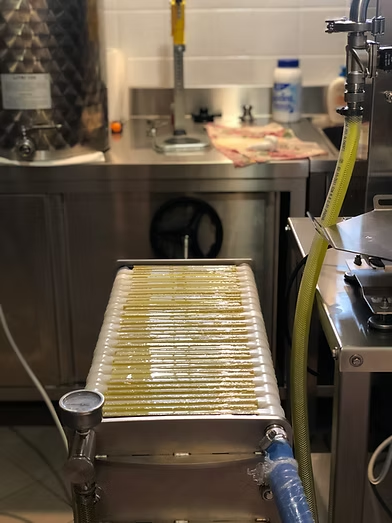La filtrazione dell'olio extravergine
Per mantenere caratteristiche le organolettiche e salutari molto più a lungo
Finito il processo di lavorazione delle olive in un frantoio moderno a ciclo continuo con estrattore a due o tre fasi e successiva lavorazione dell’olio nel separatore finale, è ormai stato assodato la necessità di una ulteriore fase di lavorazione, ovvero la filtrazione.
La filtrazione si rende necessaria perché l’olio in uscita dal separatore finale si presenta con un aspetto “velato”. La velatura è data dal fatto che al proprio interno sia presente ancora dell’acqua e dei frammenti solidi di oliva. La quantità di queste sostanze (acqua e solidi in sospensione) variano molto dal tipo di estrazione effettuato in frantoio, ma resta il fatto che nel tempo, queste particelle andranno a modificare in modo sostanziale il sapore e l’integrità organolettica dell’olio, dando luogo a difetti sensoriali tipo “morchia” e favorendo un processo di invecchiamento precoce dell’olio.

Il problema è sempre stato noto, tanto è vero che nella tradizione una parziale soluzione è stata offerta dai travasi dell’olio da una cisterna ad un’altra, generalmente effettuati a cadenza regolare. Ma questa pratica non elimina immediatamente il problema e soprattutto non permette di offrire una garanzia al consumatore, invogliato all’acquisto dell’olio nel periodo immediatamente successivo, quando il processo di posa è solamente iniziato.
La nostra scelta aziendale è quella di filtrare l’olio immediatamente.
Sebbene l’olio non filtrato possa offrire una idea di maggior genuinità al consumatore ed ai nostri clienti, questa rimane solo una idea.
Un olio filtrato, infatti, sarà molto più stabile nel tempo, tendenzialmente risulterà più equilibrato al palato e permette di offrire una garanzia in più al consumatore che troverà gli stessi gusti dal momento dell’acquisto fino a quando non finirà di consumare la sua confezione di olio extra vergine di oliva.
L’olio rimarrà, infatti, fruttato, amaro e piccante molto più a lungo, offrendo sensazioni sensoriali stupefacenti anche dopo diversi mesi dopo la frangitura delle olive.
Personalmente, per le nostre quantità di produzione, utilizziamo un filtro a piastre e strati filtranti. Il principio di funzionamento del filtro è molto semplice ma allo stesso tempo molto efficace. Ci sono le piastre di ingresso dell’olio e quelle di uscita, fra i due tipi viene messo lo strato filtrante. L’olio viene pompato tramite una pompa da travaso con girante in nitrile da una cisterna e spinto ad una pressione max di 2 bar, in modo che attraversi lo strato filtrante. All’uscita del filtro è direttamente collegata la cisterna di destinazione.
È una procedura che richiede molta attenzione ed è piuttosto lenta, a seconda della pulizia dell’olio è necessario cambiare i filtri (sgrossanti) fra i 300 ed i 500 lt di olio filtrato. Quando la pressione di ingresso aumenta e non si è più soddisfatti del grado di filtrazione, è tempo di sostituire i filtri. Una operazione molto lenta e che richiede attenzione.
Recandoci quotidianamente in frantoio, filtriamo l’olio ogni tre o quattro giorni, appena abbiamo una quantità sufficiente per iniziare la filtrazione cercando di limitare lo spreco di olio ed il costo del processo.
Il nostro filtro ha 40 piastre da 20 cm per 20 cm in moplen, un materiale utilizzato in ambito alimentare molto sicuro e facilmente pulibile. La struttura è in acciaio inox.
Per quel che riguarda lo strato filtrante, qui si apre un mondo. Ce ne sono di moltissimi tipi (cartoni, cellulosa etc) con diversi gradi di filtrazione, dallo sgrossante al brillantante. Noi utilizziamo uno strato sgrossante per evitare di fare una filtrazione troppo spinta. Il risultato ci pare comunque ottimo ed i nostri clienti rimangono molto soddisfatti.

